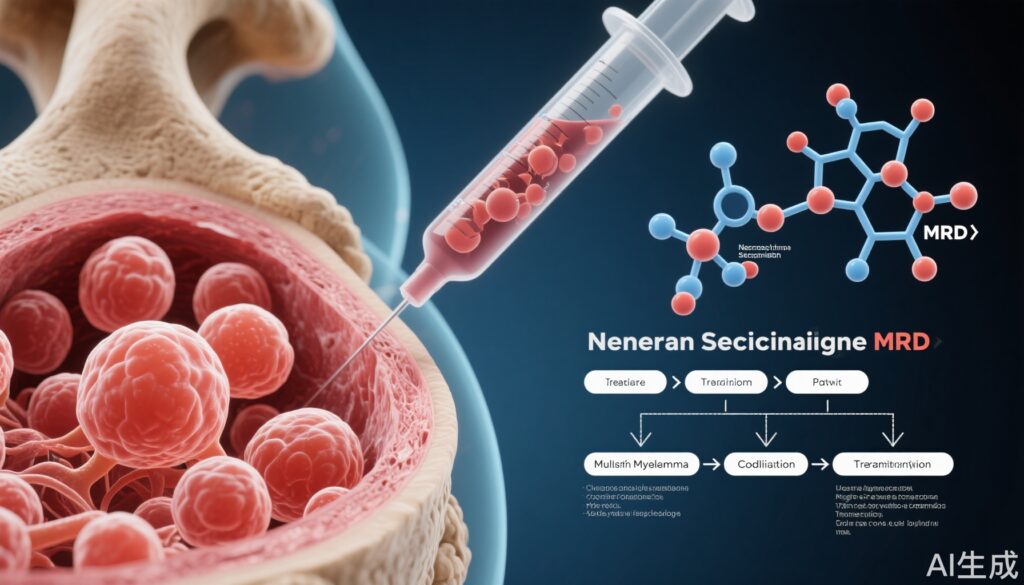Highlights
– MRD-guided strategies did not significantly increase deep remission rates versus standard consolidation in newly diagnosed, transplant-eligible myeloma patients.
– Both MRD-negative and MRD-positive groups showed high rates of MRD negativity at enhanced sensitivity following consolidation, regardless of assignment.
– No new safety signals were reported, and the clinical benefit of MRD-adapted consolidation remains unproven.
Clinical Background and Disease Burden
Multiple myeloma (MM) is a hematologic malignancy characterized by clonal proliferation of plasma cells in the bone marrow, leading to end-organ damage and significant morbidity. Despite advances in induction regimens—often combining proteasome inhibitors, immunomodulatory drugs, monoclonal antibodies, and corticosteroids—most patients ultimately relapse. Autologous stem-cell transplantation (ASCT) remains a standard consolidation therapy for eligible patients, offering improved response depth and durability. However, relapse remains common, highlighting a need for more precise risk stratification and therapy adaptation.
Measurable residual disease (MRD) assessment has emerged as a highly sensitive prognostic tool in MM. MRD negativity, especially at deep thresholds (e.g., 10^-5 or 10^-6), is strongly associated with prolonged progression-free and overall survival. Whether MRD status can be used to guide consolidation strategies, especially to modulate the intensity of post-induction therapy, is a critical and timely clinical question.
Research Methodology
The MIDAS phase 3 trial (NCT04934475) was designed to evaluate whether consolidation therapy tailored to MRD status improves deep remission rates in newly diagnosed, transplant-eligible myeloma patients. After induction with isatuximab, carfilzomib, lenalidomide, and dexamethasone (Isa-KRd), patients were stratified by MRD status at a sensitivity of 10^-5 (via next-generation sequencing).
– MRD-negative patients (<1 myeloma cell per 100,000 normal cells) were randomized to:
1. ASCT followed by two cycles of Isa-KRd (ASCT group), or
2. Six cycles of Isa-KRd (Isa-KRd group).
– MRD-positive patients were randomized to:
1. Tandem ASCT (two ASCTs in short succession), or
2. Single ASCT plus two cycles of Isa-KRd.
The primary endpoint was the proportion of patients with MRD negativity at 10^-6 sensitivity (one myeloma cell per million normal cells) prior to maintenance therapy. Safety and progression events were also monitored. The median follow-up was approximately 16.5 months across groups.
Key Findings
Among 485 patients MRD-negative at 10^-5 after induction:
– MRD negativity at 10^-6 pre-maintenance was achieved in 86% of the ASCT group and 84% of the Isa-KRd group (adjusted RR: 1.02; 95% CI: 0.95–1.10; P=0.64), demonstrating no significant difference.
Among 233 patients MRD-positive at 10^-5 after induction:
– 32% in the tandem ASCT group and 40% in the single ASCT group achieved MRD negativity at 10^-6 (adjusted RR: 0.82; 95% CI: 0.58–1.15; P=0.31), also not statistically significant.
– Notably, 15% of the tandem ASCT group did not undergo the second transplant, potentially confounding the results.
Adverse events included five cases of disease progression and two deaths unrelated to progression, all in the Isa-KRd or tandem ASCT arms. No new or unexpected safety signals were reported.
| Group | MRD-neg at 10^-6 (%) | Statistical Comparison |
|---|---|---|
| ASCT (MRD-neg at 10^-5) | 86 | RR 1.02 (95% CI 0.95–1.10) |
| Isa-KRd (MRD-neg at 10^-5) | 84 | P=0.64 |
| Tandem ASCT (MRD-pos at 10^-5) | 32 | RR 0.82 (95% CI 0.58–1.15) |
| Single ASCT + Isa-KRd (MRD-pos at 10^-5) | 40 | P=0.31 |
Mechanistic Insights and Biological Plausibility
MRD negativity correlates strongly with sustained remission and better survival in MM. The rationale behind MRD-guided intensification is that deeper molecular remissions could be achieved in MRD-positive patients by escalating consolidation (e.g., tandem ASCT), while de-escalation could spare MRD-negative patients from unnecessary toxicity. However, the present trial shows that intensifying consolidation based on MRD status did not translate to higher MRD negativity at deeper thresholds, possibly due to ceiling effects of induction regimens or the inherent biology of resistant subclones.
Expert Commentary
Current international guidelines recognize MRD as a major prognostic and potentially predictive biomarker in myeloma, but do not yet endorse MRD-adapted therapy outside clinical trials. As Dr. Philippe Moreau (not involved in this study) recently noted, “MRD negativity is a powerful goal, but we must learn how best to use this information to personalize therapy without exposing patients to unnecessary risks or cost.” The MIDAS trial’s results indicate that MRD-adapted consolidation, at least with current regimens and sequencing thresholds, may have limited added value over standard approaches.
Controversies and Limitations
– Median follow-up was relatively short (~16.5 months), limiting conclusions about long-term outcomes such as progression-free or overall survival.
– The study focused on molecular response; clinical endpoints like survival or quality of life were not primary measures.
– 15% of the tandem ASCT group did not receive the second transplant, diluting the potential effect of intensified therapy.
– The trial was conducted in a highly selected, transplant-eligible population, limiting generalizability to older or frailer patients.
Conclusion
The MIDAS phase 3 trial provides high-quality evidence that MRD-guided consolidation therapy does not significantly increase deep molecular remission rates compared to standard approaches in newly diagnosed, transplant-eligible myeloma patients. These findings challenge the routine use of MRD-adapted intensification in this setting and support continued reliance on established consolidation regimens. Further research is needed to clarify the optimal role of MRD monitoring in tailoring therapy, especially as next-generation agents and immunotherapies evolve.
References
Perrot A, Lambert J, Hulin C, et al.; MIDAS Study Group. Measurable Residual Disease-Guided Therapy in Newly Diagnosed Myeloma. N Engl J Med. 2025 Jul 31;393(5):425-437. doi: 10.1056/NEJMoa2505133. Epub 2025 Jun 3. PMID: 40459097.
Kumar SK, Callander NS, Hillengass J, et al. NCCN Guidelines Insights: Multiple Myeloma, Version 1.2024. J Natl Compr Canc Netw. 2024;22(1):4-21.
Avet-Loiseau H, et al. Minimal residual disease status as a surrogate endpoint for progression-free survival in multiple myeloma: A meta-analysis. J Clin Oncol. 2020;38(24):2419-2429.


